 Written by Mike Price, OT
Written by Mike Price, OT
Wheelchair users are among those who are at risk for pressure sores, because spending a lot of time in one position puts constant pressure on some areas of skin. This pressure deprives skin cells of oxygen and can cause wounds to the skin that don’t easily heal unless active steps are taken to relieve the pressure on those areas. Reclining and tilt-in-space wheelchairs both change the posture and center of gravity for the user, helping relieve some of that constant pressure.
Although both a reclining back wheelchair and a tilt in space wheelchair reposition the user, a reclining back wheelchair transitions from a seated position to almost lying down. This position change reduces pressure on the rear. One downfall is that patients often slide their back up and down the back of the chair when it is reclined or set back upright. This can cause shearing, which stresses the skin. The reclining back wheelchair changes the user’s posture. If the user can’t sit up straight without assistance, there is a risk of sliding out of the chair or leaning to one side when reclined.
A tilt-in-space wheelchair keeps the user’s posture the same, while the whole seat tilts backward. This redistributes pressure away from the hips and onto a larger surface area. Without slipping or the risk of skin shearing, this position helps to reduce the risk of bedsores and keeps the back properly aligned to address back pain.
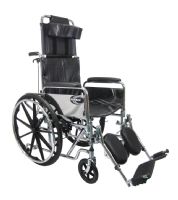 | Standard Deluxe High Back Reclining Wheelchair by Karman Healthcare View Product |
If a wheelchair user wants or needs to recline at incremental angles without exerting much energy, a reclining wheelchair provides that opportunity. Users have more control over their own comfort than with a standard non-reclining wheelchair. A high-back reclining wheelchair has a higher chair-back with an independent reclining function that allows for a 90-degree seated position to a 180-degree decline. Not only does the recline function provide more comfortable seating options, it also helps improve the user’s blood flow.
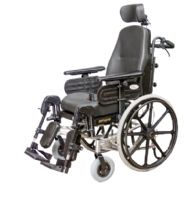 | Spring Tilt-in-Space High Back Wheelchair View Product |
There are many benefits for users in a tilt-in-space wheelchair. For people with severe mobility impairments that need the aid of a lift for transfer into a chair, a tilt-in-space wheelchair ensures proper positioning that can match the posture maintained in the lift sling. Also, for people who are at risk of developing pressure sores, using a tilt-in-space wheelchair and regularly changing the tilt angle redistributes weight along with pressure points and helps defend against developing pressure wounds. For patients who are severely bent forward, a rear tilting angle can help them see in front of them. For anyone spending a lot of time in a wheelchair, the tilt design allows the user to be tilted all the way back for resting or sleeping.
Below are some types of reclining wheelchairs and our top-selling products.
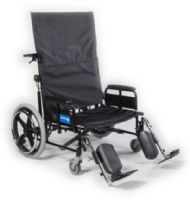 | Reclining Bariatric Regency 525 Wheelchair by Graham Field View Product |
Standard reclining wheelchairs typically are built to accommodate users weighing up to 250 pounds. Heavy-duty reclining wheelchairs are wider and have weight capacities ranging from 450 to 600 pounds. Some bariatric wheelchairs can safely carry users weighing up to 800 pounds. Bariatric wheelchairs with tilting seats adjust to the user’s center of gravity, helping alleviate hip and back pain and breathing difficulties.
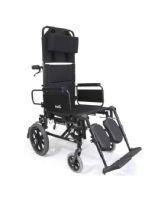 | Ultra Light Weight Transporting Recliner Wheelchair by Karman Healthcare View Product |
For anyone who travels, portable lightweight folding models are the easiest to transport. They weigh much less than their standard counterparts, so they are easy to put in the back of a van until the chair is put into service.
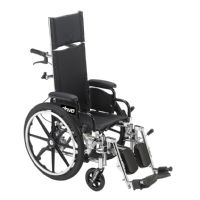 | Drive Medical Viper Plus Reclining Wheelchair View Product |
Low or hemi-height seat wheelchairs are ideal for people who want to remain mobile, as the lower seat allows for user foot propulsion. This design provides the benefits of having a reclining seat at the ready when helpful, but also encourages independence for as long as possible with users being able to use their feet to move the wheelchair.
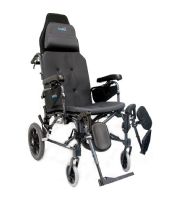 | Transport Reclining Wheelchair by Karman Healthcare View Product |
Transport chairs combine the function of a wheelchair with the portability of a rollator. They have small wheels and are not self-propelled, so they only work when there is a caregiver present to push the chair.
 | Drive Medical Viper Plus Reclining Wheelchair View Product |
For people who spend the majority of their waking hours in a wheelchair, that chair needs to be durable enough to last. A wheelchair with a steel frame, chip-proof finish, and quality upholstery will stand up to time and deliver a long service life.
~1.jpg&newwidth=365&maxheight=200) | Reclining Wheelchair - Karman Healthcare MVP-502-TP View Product |
One of the disadvantages of a reclining wheelchair is the tendency for users to slide when it is being tilted up or down. This can cause skin shear and make skin issues, which are hopefully addressed by repositioning, to arise from this slipping. V-shaped seats can prevent sliding for users who are unable to hold their position and prevent skin shear with a standard wheelchair seat.
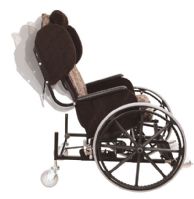 | Rock-King X3000 Tilting Wheelchair View Product |
Because the rocking motion has a calming effect, a wheelchair that rocks like a rocking chair can have a big impact on users with dementia or other conditions that leave them confused and under stress. Rocking chair therapy has been proven to work in a variety of situations and conditions, especially with the elderly and those suffering from memory-related issues.
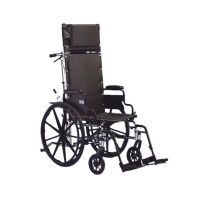 | Invacare Tracer SX5 Recliner Wheelchair View Product |
Every patient is unique, and when you need a wheelchair to meet your specific needs and wants, it’s not necessary to buy “off the shelf.” You can outfit a wheelchair with options that make it more comfortable and useful for you, from the type of armrests and footrests to seat height to wheel size and how much storage you want. There are so many options available, you don’t have to settle for something that isn’t “just right.”
Here are some specialty tilt-in-space wheelchairs and our best-sellers.
.jpg&newwidth=365&maxheight=200) | Kanga Adult Tilt in Space Wheelchair View Product |
Children and teens who aren’t done growing can grow out of a wheelchair as surely as they grow out of their shoes. To make the most of the investment in a pediatric wheelchair, buying one that is expandable to grow along with your child for years to come will keep you from having to replace one after every growth spurt.
.jpg&newwidth=365&maxheight=200) | Broda Vanguard Positioning Wheelchair (Bariatric) (985) View Product |
Bariatric tilt-in-space wheelchairs not only handle higher weights than standard wheelchairs (in the 500-700 pound range), they can have completely different designs to accommodate the unique needs of bariatric patients to keep them safe and comfortable whether tilted or upright.
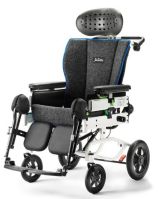 | Ormesa Juditta Tilt-In-Space Manual Wheelchair View Product |
Spending significant time in a wheelchair can put significant pressure on the spine. A design specifically created to provide proper spinal alignment without generating any pressure on the spine itself provides not only healthy postural support, but relief from pressure and possible pain.
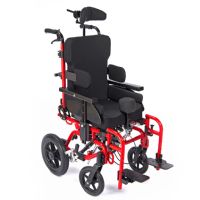 | Kanga Pediatric Tilt in Space Wheelchair View Product |
For growing kids who are wheelchair-bound, it’s important to have a wheelchair that can create a comfortable environment for them to experience the world. A chair that ensures proper positioning as they grow, and ideally is expandable to grow with them, can greatly increase the quality of life for a wheelchair-bound child.
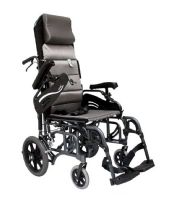 | VIP 515 Tilt In Space Lightweight Wheelchair by Karman Healthcare View Product |
Not all lightweight tilting wheelchairs fold up, but if you are on the go, a portable model that folds can make a major impact on your ease of transport.
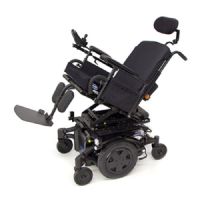 | TDX SP2X Power Wheelchair - Single or Multiple Power Function by Invacare View Product |
For people who do not accept limits, who seek to be able to navigate over uneven terrain, a powered tilt-in-space wheelchair provides the comfort and repositioning benefits of a tilt chair. Being self-propelled, the user doesn’t have to expend a lot of energy to move, and can enjoy the independence of not having to rely on someone else to push the chair.
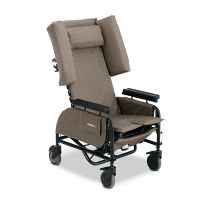 | Broda Latitude Pedal Wheelchair (Rocking) (48R) View Product |
Promoting independence, contentment, and stimulation with an element of mild exercise, tilt chairs that have a rocking component are especially beneficial for people with dementia.
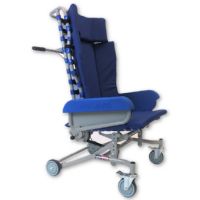 | FreedomFlex Pedal Tilt-In-Space Reclining Wheelchair by Med-Mizer View Product |
Not all transport chairs are able to be self-propelled, so it’s a special feature if you find one that can. A transport chair that can be self- or caregiver-propelled leaves lots of options open, including maintaining independence.
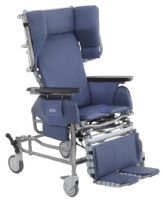 | Broda Elite Tilt Wheelchair (85V) View Product |
Different patients need different levels of support. Tilt-in-space chairs that are designed to accommodate a variety of positioning pads and supports are a great choice to meet the individual needs of someone who needs the comfort and pressure prevention of a tilt wheelchair.
Spending a lot of time in a wheelchair puts a user at risk of pressure ulcers, which form when skin and soft tissue are pressed against a harder surface for extended periods. The pressure reduces blood supply to the area, which can lead to pressure wounds that don’t always heal easily and can leave the user open to potential infections. Depending on the ability of the user to self-position, the amount of pressure relief provided by a wheelchair is an important factor in considering which wheelchair is the best for purchase.
Adjustability comes in many forms when it comes to wheelchairs. It might mean a frame that adjusts to accommodate a growing child, positioning pads available to add or take away to design optimal support, or the amount of recline or tilt and ease of use offered by a chair.
Since the wheelchair headrest supports, aligns, and stabilizes the head and neck in the most functional position, it is an important part of the seating system in a reclining or tilt-in-space wheelchair.
Comfort has to be one of the main considerations for anyone spending a majority of the day sitting in a wheelchair. There are so many pressure points that stress skin and joints and bones that padding to create the most comfortable seating can really improve the quality of time spent in the wheelchair.
A properly sized seat and chair will contribute to a better user experience. A seat that’s too narrow will squeeze the user, and one that’s too big will not provide correct positioning support. Certain seat shapes can help fight skin shearing by minimizing slipping, while others provide back support that relieves pressure on the spine.
Most, but not all, transport wheelchairs are not built for self-propulsion because of their small wheels. Some can be foot self-propelled, but they can’t be pushed by the wheels like a standard big-rear-wheel design. For people who don’t have constant access to a caregiver, a self-propel option is attractive, while having a caregiver always on hand to push a wheelchair makes any model an option.
A: Yes, and having the option to recline can make the wheelchair a more comfortable place to rest or nap.
A: A tilt chair is another name for a tilt-in-space wheelchair, which has a seat frame that tilts backward in varying degrees, with the user in the same seated position but tilted backward.
A: Research shows it should be tilted at least 35 degrees when combined with recline at 100 degrees, and at least 25 degrees when combined with recline at 120 degrees.
A: The average weight of a reclining wheelchair is between 50 and 70 pounds.
A: A reclining wheelchair allows the user to sit up straight and recline as far as lying flat at almost 180 degrees. The knees can also be raised to stretch the hips and lower back. It can extend from a wheelchair to a platform for repositioning, resting, or sleeping.
Since wheelchair-bound patients are at a greater risk for skin breakdown and pressure sores, as well as postural alignment issues that can cause stress and pain in joints and bones, the ability to change positions and relieve pressure points is imperative for good health. A reclining wheelchair takes the pressure off in different ways than a tilt-in-space wheelchair does, but the goal of each is the same - to provide the most comfort and pressure relief for the user.
Pressure relief, the ability to accommodate individual patient needs, and ease of use for patients and caregivers all contribute to the quality of daily life for anyone who spends most of the day in a wheelchair. Other factors to consider are portability and durability, to ensure a wheelchair user has plenty of opportunities to get out into the world.
Check out our great selection of Reclining Wheelchairs and Tilt In Space Wheelchairs.
Thanks for reading about the differences, features, and things to consider when choosing a reclining or tilt-in-space wheelchair. Visit Caregiver University to explore our extensive article library, including more information on how to pick the best wheelchair for your needs.

Co-Founder of Rehabmart and an Occupational Therapist since 1993. Mike has spent his professional career working in multiple areas of Occupational Therapy, including pediatrics, geriatrics, hand therapy, ergonomics and inpatient / outpatient rehabilitation. Mike enjoys writing articles that help people solve complex therapeutic problems and make better product choices.